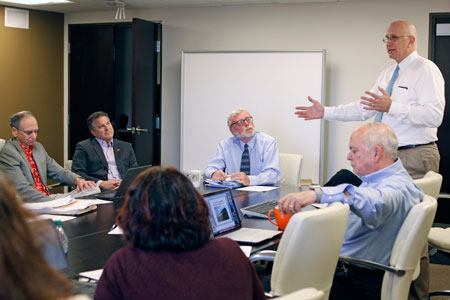Originally published March 23, 2016
By Daniel Perez
UTEP Communications
“Oomph” is a nebulous substance to quantify, but a UTEP committee working with the designers of the planned Interdisciplinary Research Building on campus aim for a concept that will provide The University of Texas at El Paso with plenty of oomph for decades to come.
University President Diana Natalicio formed the 11-member team in late 2015 to study the optimum use for the $85 million, 150,000-square-foot, five-story structure that will be built at the southeast corner of Sun Bowl Drive and University Avenue. The project is on schedule to break ground in January 2017 and should be open for the fall 2020 semester.

The group has sent out online surveys and conducted focus groups and one-on-one interviews with approximately 120 campus educators involved in or who have expressed interest in interdisciplinary research. It recently launched its website – idrb.utep.edu – to explain its vision and offer a transparent guide to information the team has gathered so far. It also includes a form to submit comments or suggestions for the building.
The team, in collaboration with the Houston architectural firm of Perkins+Will and San Antonio-based Facility Programming and Consulting, is focused on creating a state-of-the art building capable of tackling the big challenges of today and tomorrow in a novel way on a large scale.
“We’re interested in what it’s going to take to elevate UTEP to the next level in terms of our interdisciplinary research enterprise,” said William Hargrove, Ph.D., director of UTEP’s Center for Environmental Resource Management, and the team’s chair. “We’re always looking at what’s going to give us that little oomph.”
Hargrove said there is general excitement among faculty about how the building will look and what it will be able to do. Among the common themes shared by faculty include that the plan should be based on function and not individuals, it should have spaces that promote collaborations, and there should be a focus on shared research resources, or core facilities.
Among those involved in the focus groups was Doug Lowe, president of Facility Programming, who is working with the University to develop the “recipe” of ingredients for the building that will serve as a guide for architects and engineers.
He said the uniqueness of this building excites him. Whereas most research buildings are aimed at a particular audience such as nurses, scientists or engineers, the purpose of this one is different and that difference is huge. He praised President Natalicio for her vision and leadership, and the planning team for resisting the temptation to create a newer version of an existing UTEP building.
“The challenges associated with planning this type of building – a place to do research that has not yet been defined, by researchers who have not been identified – are very significant,” Lowe said. “This building is going to become a place where great minds from different disciplines can come together to work on research topics that will go far beyond what is possible today.”
The planning team meets about twice a month to keep up with the project’s ambitious timeline. It wants to have a basic allocation of space for offices, meeting rooms, work areas, and wet and dry labs by the end of the spring 2016 semester. The design should be completed during the summer. There also are ongoing talks about major pieces of research equipment that the University has and what it needs.
Hargrove said the proposed building will add to the University’s core values of access and excellence and become a model for other institutions. It also will help the University recruit and retain world-class faculty and eager and talented students, and engage different industries and community partners. Additionally, it should generate additional grant opportunities through agencies such as the National Institutes of Health, the National Science Foundation, the Environmental Protection Agency, and the Department of Defense that want to address society’s big issues, which often are complex and interdisciplinary.
Cecilia Hinojosa, a senior psychology major, said she jumped at the opportunity to provide student input to the committee. The El Paso native has spent the past two years involved in nicotine addiction research through UTEP’s COURI (Campus Office of Undergraduate Research Initiatives) and BUILDing SCHOLARS programs. She does her research in the Psychology Building and admits to dealing with cramped quarters.
She said students are excited about the building’s research opportunities, but she is most pleased that the faculty members she has contacted are focused on working together to achieve common goals.
“I love how UTEP provides undergraduates with the opportunity to be involved in research,” she said. “That’s what sets us apart. It’s one of the points that this new building will emphasize. I love it now, but the thought of more (research) is wonderful.”
Mechanical engineering graduate student Jorge Rosero said he appreciates the committee’s efforts to balance the building’s design with the University’s mission of access and excellence. The committee member said accommodating the campus’ diverse research communities is one of the group’s main challenges.
“It’s incredibly complicated,” said Rosero, who has conducted energy research at UTEP for almost two years as part of the Center for Space Exploration and Technology Research through COURI, and spent the summer of 2015 at Japan’s Kyushu Institute of Technology’s Space Systems Laboratory.
He has served the committee as a representative at a site visit to another institution, where he witnessed ways to repurpose resources and rearrange rooms. He also passed along the faculty’s desire for a food station where they could eat and collaborate.
Rosero expects to graduate in December 2016, a month or so before the building’s projected groundbreaking, and is content to know that he contributed to a building that will enhance the University’s prestige among research institutions and bring additional value to anyone with a UTEP degree.